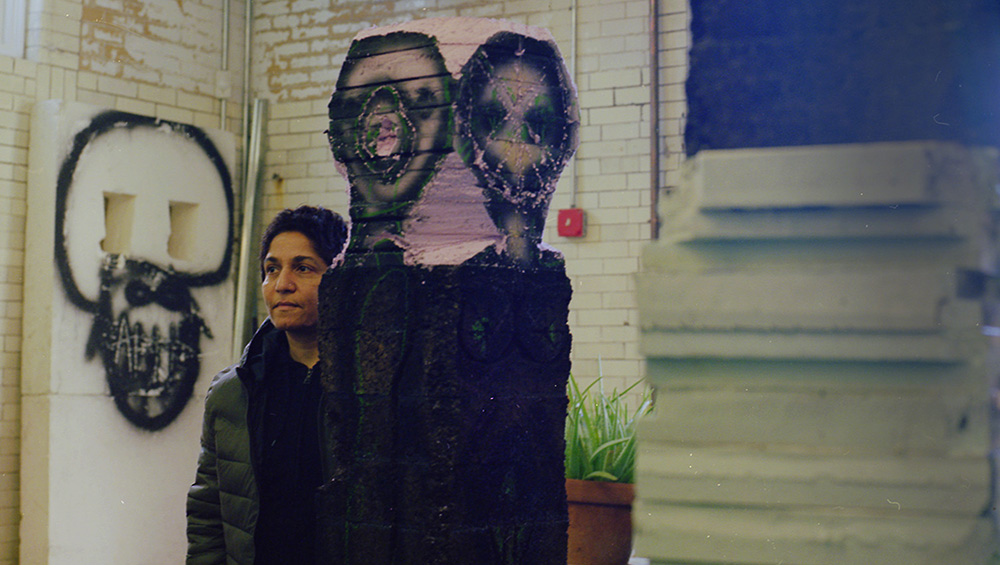
Huma Bhabha. Photo: Elyse Benenson, 2016.
by HETTIE JUDAH
Huma Bhabha’s explorations of the figure – human, divine, monstrous, alien – meld elements of the contemporary, the modern and the very ancient. Bhabha’s points of reference include science fiction and horror movies, including Alien and Terminator. In her transformation of found materials, she looks not only to arte povera, but the work of Robert Rauschenberg and Joseph Beuys. Often her sculptural works are pockmarked, abraded or part-destroyed, although this does not necessarily suggest ancient or archaeological origins: as the artist had pointed out, many places in the world are in a state of living ruin as a result of war, poverty or natural disaster.
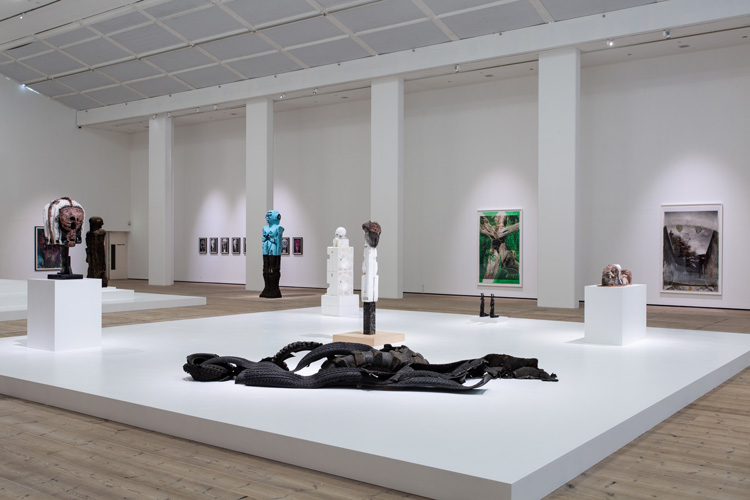
Huma Bhabha, Against Time. Installation view, Baltic Centre for Contemporary Art 2020. Photo: Rob Harris © 2020 Baltic.
Based since 2002 in Poughkeepsie, New York, Bhabha (b1962) moved to the US from Karachi, Pakistan in 1981, and studied printmaking at the Rhode Island School of Design before taking an MFA at Columbia University in 1989. Resident in New York during 9/11, she witnessed the xenophobia that accompanied US military intervention in the Middle East and Central Asia. We Come in Peace, her acclaimed 2018 Roof Garden Commission for the Metropolitan Museum of Art, New York, explored concepts of the alien and other. In 2019, her monumental bronze Receiver was installed in Wakefield as part of Yorkshire Sculpture International positioned, pointedly, at a public junction in the sightline of a statue of Queen Victoria.
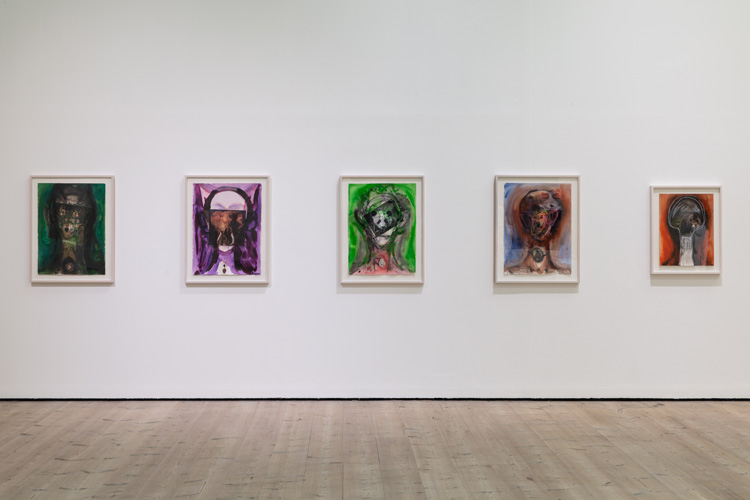
Huma Bhabha, Untitled, 2013-16. Courtesy the artist and Salon 94, New York. Installation view, Huma Bhabha, Against Time, Baltic Centre for Contemporary Art 2020. Photo: Rob Harris © 2020 Baltic.
Following They Live, a major survey at the ICA Boston in 2019, Against Time at the Baltic, Gateshead, is Bhabha’s first significant solo exhibition in Europe since her work was shown in Okwui Enwezor’s 2015 Venice Biennale. Works on paper – prints and drawings incorporating photographic and collage elements – line the gallery walls. Some present sculptural or monumental structures within deserts or ruined landscapes, others are studies of humanoid heads that emerge as more or less alien, more or less monstrous. Earlier sculptures include works such as Cargo Tomb (2005), in which unfired clay and horn have been mounted on an exposed armature of wire mesh and Styrofoam.
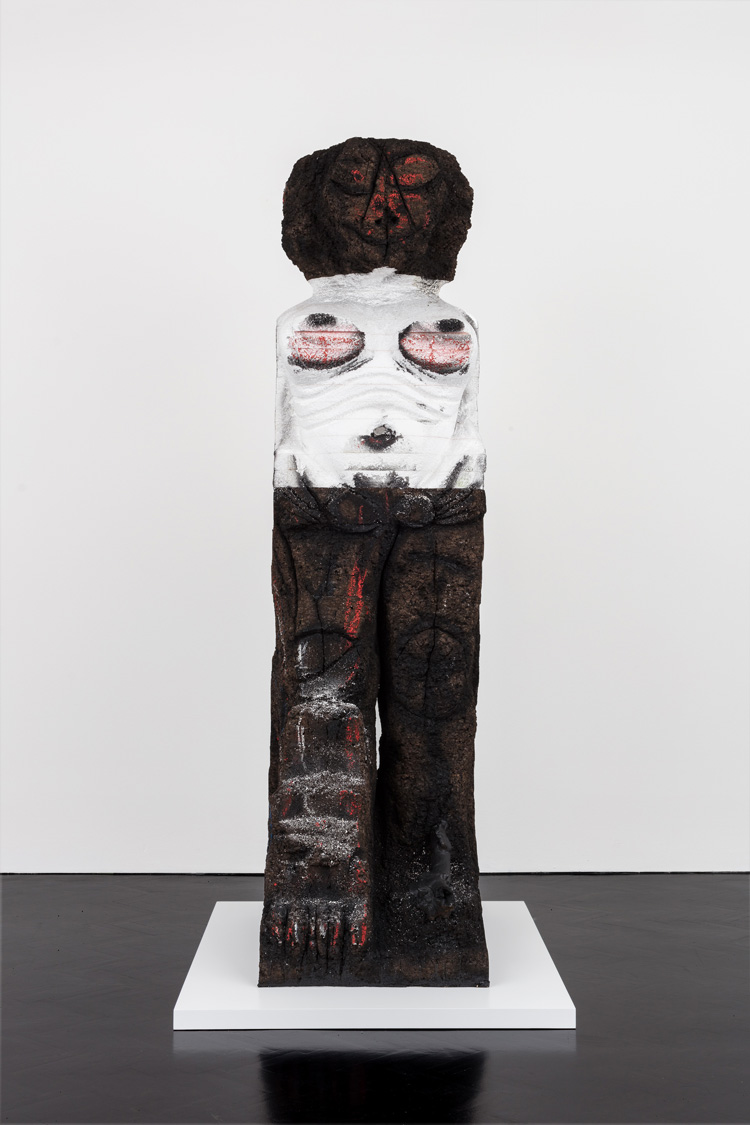
Huma Bhabha, Castle of the Daughter, 2016. Courtesy the artist and Salon 94, New York.
On a low-stepped ziggurat, Bhabha’s standing sculptures are arranged around the monumental Castle of the Daughter (2016). Carved in cork and Styrofoam, its legs and body apparently scarred and burned, the sculpture is named after the ruined Qala-e Dokhtar castle in Bamiyan, Afghanistan. A powerful broken idol in ancient and contemporary materials, Castle of the Daughter carries the horror not only of destruction at sites such as Bamiyan, but also of the value assigned to heritage sites relative to human life in the western media, and the use of cultural destruction to construct an image of a barbaric other.
Studio International talked to Bhabha about the show and the impact on it of the Covid pandemic.
Hettie Judah: How has it been setting this show up, long distance?
Huma Bhabha: The curator at the Baltic, Emma Dean, came to visit me in February, and so, since then, we’ve had a pretty clear idea. In the last few days, we’ve been having Zoom or WhatsApp conversations, so Emma can show me where things are. It’s been very smooth: it was all very well planned. Of course, you always have to tweak a few things, and swap certain sculptures because she and I had a good understanding that we didn’t want it to be too crowded. I like my shows to be very minimal, so that there’s enough time and also room, to let the different works unfold. I like a lot of space.
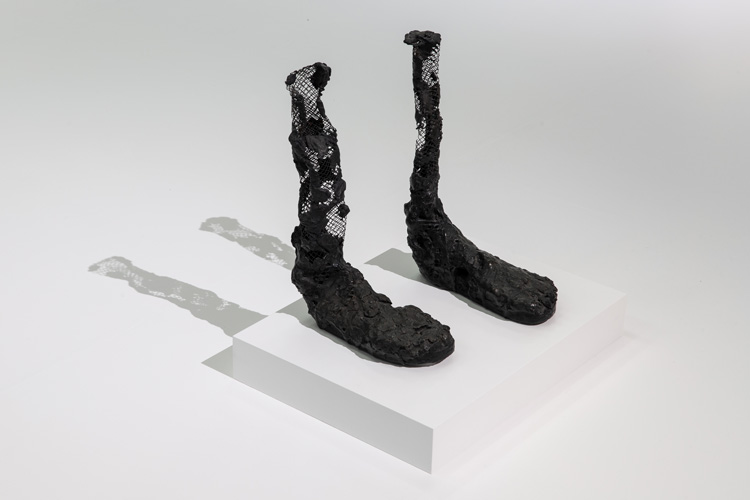
Huma Bhabha, Untitled (bronze feet), 2007. Installation view, Huma Bhabha, Against Time, Baltic Centre for Contemporary Art 2020. Photo: Rob Harris © 2020 Baltic.
HJ: There are two levels that I read into the show’s title, Against Time. Part of the intrinsic language of sculpture is the idea of defeating time, of things that endure almost like a bastion against time, living long past a human lifetime. In your choice of materials, particularly your use of waste and found objects in works such as Cargo Tomb (2005) and Atlas (2015), you seem to have an ambivalent, or even antagonistic relationship to this idea of sculptural permanence.
HB: I’ve been making sculpture for quite a long time and, initially, a lot of my choices of materials were based on what I could afford. I think that is interesting because it’s a challenge to either try to use materials and completely transform their appearance, or try to integrate them when they have their own appearance and identity. I am very fond of those kinds of materials, which are basically refuse. Bronze, which is completely permanent, I think it will last longer, but then, at the same time, materials such as Styrofoam will also last. I also like the ruined surface of sculptures.
HJ: There is another aspect to Against Time – the idea of there being particular kinds of form for a particular time. Whether that is objects that speak to modernism, or of a particular archaeological or a devotional era. Do you aim to create objects that do not look part of their own time? Your work has that temporal ambiguity.
HB: I think the issue of originality comes into play. I look at a lot of stuff, but at the same time the work has its own unique presence. Even though the materials are familiar and the references are there, it doesn’t look exactly like something that I’m thinking about. Working in the way I do gives the work its presence, original and unique in the way the materials are combined. The bronzes are, of course, bronze, but at the same time the original materials are very humble. Their presence is completely transformed once it’s in a different material, but it’s still interesting because you don’t know exactly what it is until somebody tells you: “Well, this is actually cork, and that’s carved Styrofoam.”
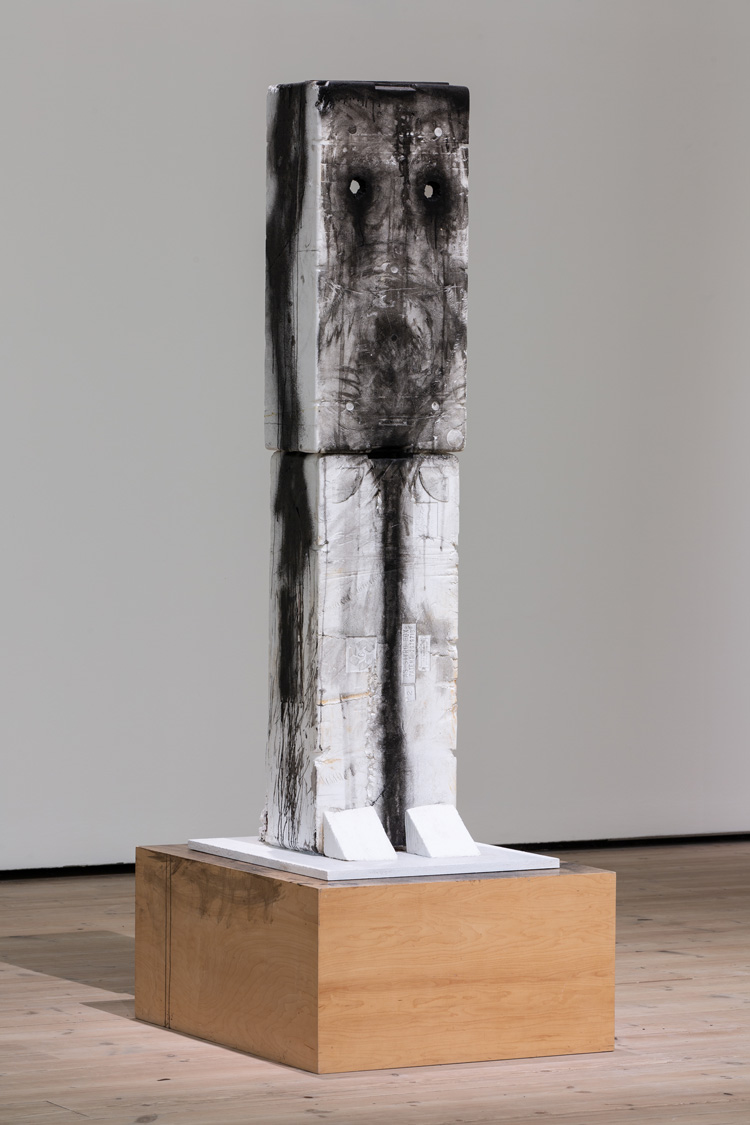
Huma Bhabha, Untitled 2006. Courtesy Peter Blum Gallery, New York. Installation view, Huma Bhabha, Against Time, Baltic Centre for Contemporary Art 2020. Photo: Rob Harris © 2020 Baltic.
HJ: Have you worked right from the start of your sculptural career with found objects, and found materials?
HB: Yes, because I wasn’t able to afford a lot of other stuff. Being introduced to assemblage and collage when I was a student already opened it up: you can basically make art of anything, and use all kinds of materials. I was interested in that kind of work. You can see in some of the clay and Styrofoam mixed media works: they are definitely an assemblage of materials that I respond to.
HJ: To what extent do you respond to the materials you have found or have available, and to what extent are you working with a pre-existing idea?
HB: I have an idea as to what I want to achieve at the end, but because of the way I work, each mark will lead to the next, or each cut. It’s not that I have no idea, but sometimes what happens is interesting, and you’re not sure: “Well, this is how I thought I was going to do it, but this looks better.” As a visual artist, what I’m really interested in, at the end of the day, is how it looks. If I need to do something radical, I will so that the final experience is a good one.
HJ: I heard that you used to work in a taxidermy workshop?
HB: I lived in New York City for about 13 years, and then moved upstate because we couldn’t afford to live there any more. I took up a job at a taxidermy workshop because I thought that would be more interesting than some weird office. It was a pretty big operation: the person I was working for was a very good taxidermist. He had a full team of people and they were doing African wildlife, big animals: rhinos, giraffes. Things that freaked me out. How can somebody do that? How can you just kill a standing animal? They worked a lot on dioramas. I really liked how they built up the armatures, it was very interesting. I got a lot out of that, because I wasn’t trained as a sculptor, I don’t have any welding experience, or anything like that. This was more building; it’s also very assemblage-related. From every experience, you learn something that you can add to your process.
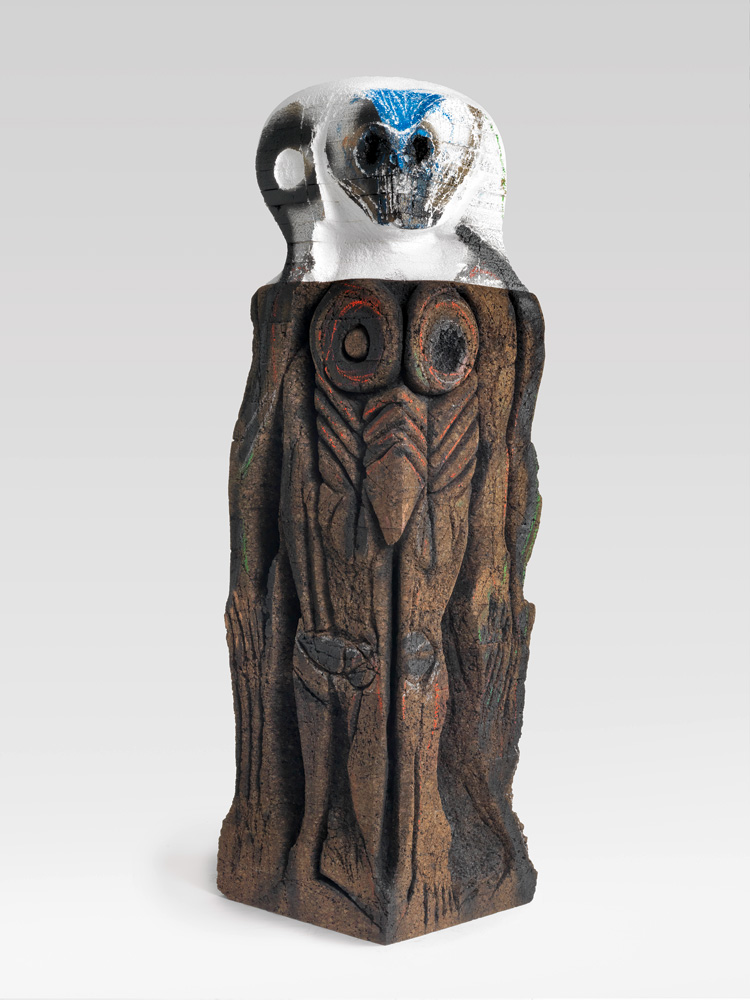
Huma Bhabha, It's Me, 2013. Courtesy of the artist and Salon 94 New York.
HJ: I can certainly see in your early sculptures with the wire and the clay – such as Call at Will (2009) – how that may have influenced your work.
HB: Yes. I use wire and I used Styrofoam because I was using that earlier on armatures because it’s very light, but extremely sturdy, when you have to move things around yourself. Everything is practical. It was also important for me, at a certain point, to realise when I stop working on a sculpture. When is it finished? Is it really finished when everything is covered with clay? I was open to the idea of looking at the work as it was becoming. Certain things were just opening up something else for me: the idea of looking through a sculpture and it looking back at you from the inside. Even though I do have very strong thoughts about a lot of things, as far as my work is concerned, I prefer that there is an ambiguity because it also allows the meaning to be bigger. It’s more of a challenge for the viewer to think more about what they are responding to, whether it’s a physical, emotional response, or if there are more things that are coming up as you slowly allow the sculpture to reveal itself.
HJ: The carved sculptures, such as Castle of the Daughter (2016), are a bit destroyed: they have been subject to the violence of their own making, they are gouged into and, in some cases, fragmented, or apparently burned. But they also feel like power objects: potent and totemic. They have this very radiant, idol-like presence. I am very interested in this dichotomy. Do you see the carving process as violent?
HB: Yes. I guess I’m referring to my love of idols. The process is not so violent, because I’m using materials that I can carve myself. Cork is soft. It’s not a hard material, but the surface is beautiful. In around 2008, I made my first carved object out of cork. I’ve slowly become better at it: I know how much pressure to apply, and what kind of cuts to make, so I don’t make mistakes, but the thing is that I thrive on my own mistakes. So, if something opens up I think it gives it more action within the sculpture. It happens by itself, but I’m in control of it. It’s more about a formal response to each mark. I see myself as an expressionist, that obsessiveness and aggressiveness is myself, and the kind of marks I want. At the moment, I am working on some clay pieces with wire and plaster, and, at the same time, I am working on bronzes that are actually cork: a mixture. It’s interesting how I can go back and forth between the two different materials, and sometimes they feed each other. I work from piece to piece, but it’s an ongoing thing. It’s not bodies of work. They keep informing each other.
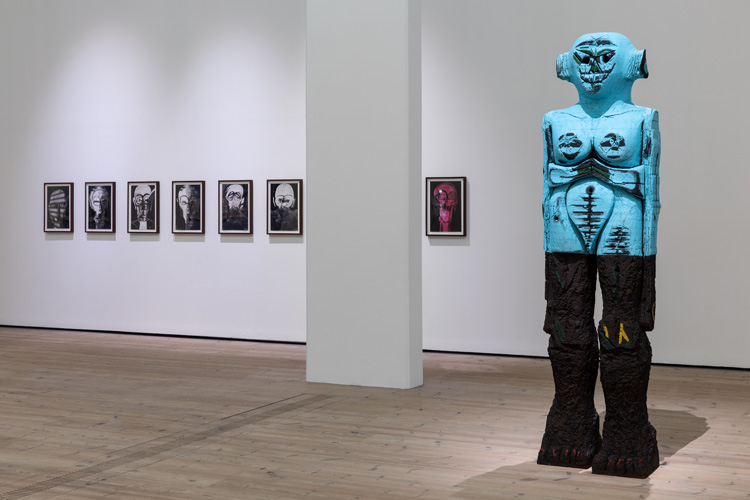
Huma Bhabha, Untitled, 2009 and Receiver, 2018. Courtesy the artist and Salon 94, New York.
Installation view, Huma Bhabha, Against Time, Baltic Centre for Contemporary Art 2020. Photo: Rob Harris © 2020 Baltic.
HJ: When I saw Receiver (2019) in Yorkshire Sculpture International last year, I did not see it as a gendered form, but having now seen this whole related group of cork and Styrofoam pieces together, they seem very strongly female. Do you see them as gendered pieces?
HB: The thing is that, yes, Receiver is quite female. I prefer that it’s more fluid, but lately they have been becoming more female. I do have male figures. Untitled (2010) is a male figure, I think, more so. What is Love (2013) is more fluid. It’s more about the form, and how you compact a form, and I’m also looking at a lot of stone sculpture from the Gandhara civilisation. I’m very interested in compacting the form, and exaggerating it at the same time, and I want to do it to both sexes, if it’s possible, and it’s interesting to make different genitalia in different ways. I love the different ways I can express all that in the figure.
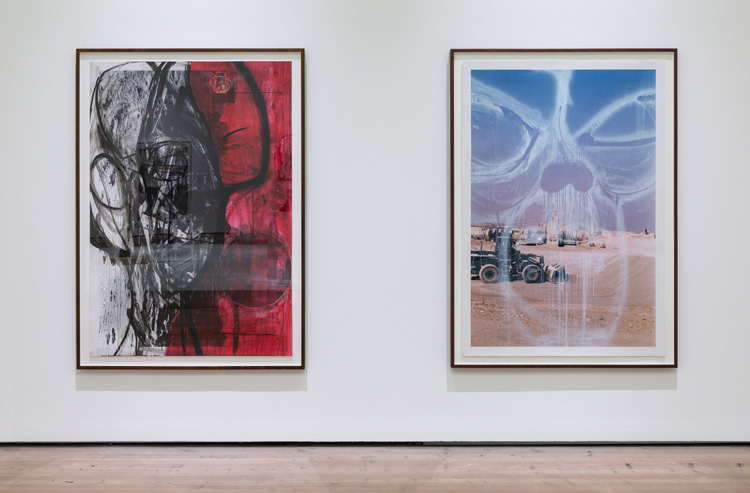
Huma Bhabha, Untitled, 2013 and Untitled, 2011. Courtesy the artist and Salon 94, New York. Installation view, Huma Bhabha, Against Time, Baltic Centre for Contemporary Art 2020. Photo: Rob Harris © 2020 Baltic.
HJ: I have been surprised by the humorous and whimsical aspect to some of your work at the Baltic, particularly in the collaged paintings with the animal faces, or marijuana buds. And the little photographs pasted into the bottom of sculptures. It is not an aspect of your work I had been aware of from just seeing your work in reproduction.
HB: The humour’s always been there, but it’s hidden. I don’t want to be incredibly funny, but when you’re interested in certain things, like horror and science fiction, there is a certain nerdy humour that goes with that. These little bits of collage keep coming back from earlier work. I collect a lot of art invitations, interesting photos here and there that I find. I like a lot of animal pictures, because I’ve started using them for my drawings. I thought that was interesting, how they morph. This goes back to being interested in artists such as Arnulf Rainer, how he has defaced his photos of himself, and that way of bringing that expressionistic mark-making within the drawings and the portraits. Even within the mixed media sculptures, there are sometimes little things inserted, or left there, or glued on, which you only would notice if you were to look at it over and over again.
With the weed images collaged, in the drawings, it’s because a friend of mine gave me a High Times magazine, and they have these beautiful images, centrefolds of buds, and I started to cut them out, and use them as eyes: they almost break through the space. You go into another dimension. It’s odd because sometimes people don’t automatically recognise it, but I think it’s also the quality of the two different photographs next to each other. I think humour is extremely important. Otherwise, it would become a bit one-dimensional, and that’s what I really don’t want: a one-read. The more complicated and layered the work is, the better for me.
Huma Bhabha: Against Time is at the Baltic, Gateshead, until 21 February 2021.